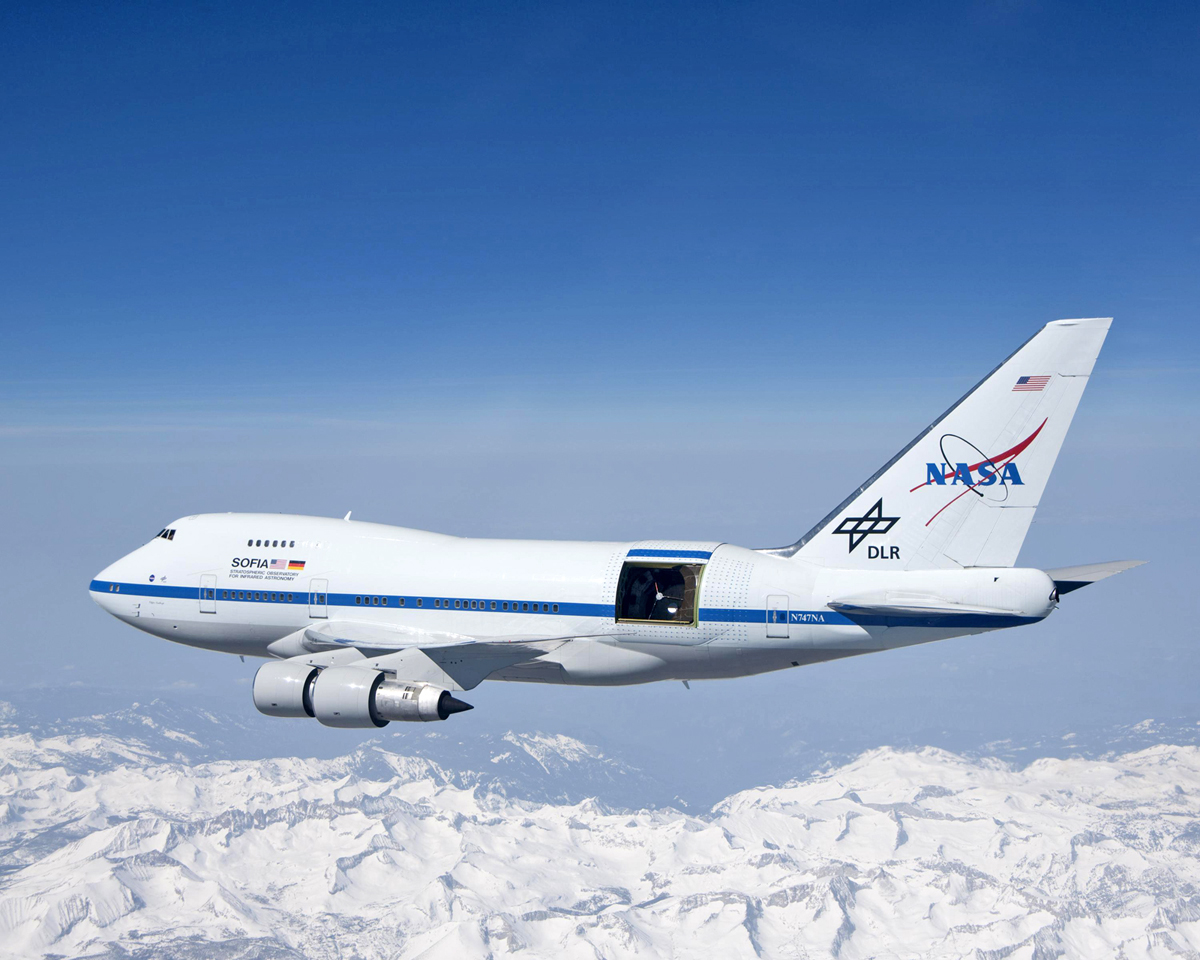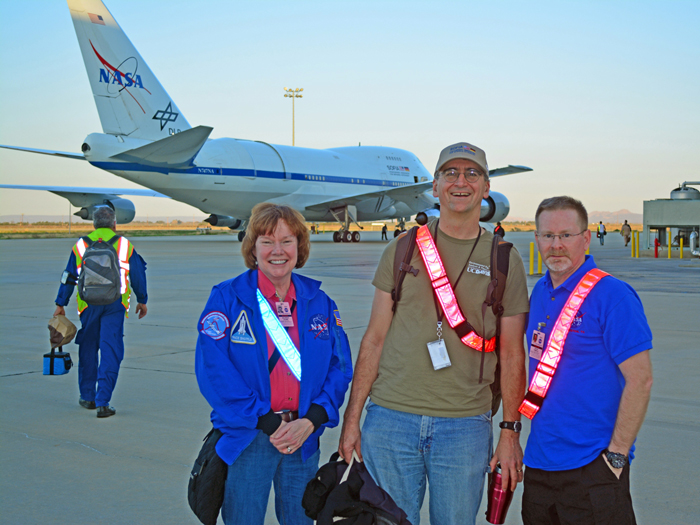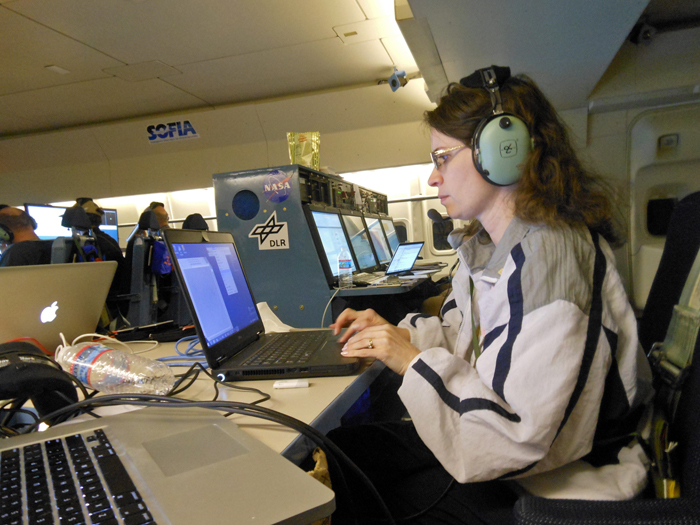
A Department of Astronomy outreach program achieved the culmination of 17 years of hard work recently when several Texas teachers flew as part of the science team aboard NASA’s Stratospheric Observatory for Infrared Astronomy (SOFIA).
|
Second in a series |
The teachers were part of the EXES Teacher Associate Program, which began in 1998 back when plans for the construction of SOFIA, the world’s largest flying astronomical observatory, and its instruments were still in their infancy. The goal was for a group of Texas teachers to get a firsthand look at the development of a scientific instrument for SOFIA, from beginning to end, so that they could convey that unique experience to their own students.
"The teachers can take the science and the real research that they’re learning here and use it in their classroom," said Dr. Keely Finkelstein, education team lead for the Teacher Associate Program and a research associate in astronomy at The University of Texas at Austin.
Since the program began, the Teacher Associates have attended regular meetings where they met astronomers and learned about their research. They were kept up-to-date on the status of SOFIA and EXES as the two technologies were slowly realized. The teachers also received continuous hands-on experience doing astronomical observations at the McDonald Observatory.
What is SOFIA?
 SOFIA consists of a 100-inch, 17-ton telescope housed within a repurposed Boeing 747SP (SP for Special Performance) airplane. The plane carries the telescope and crew up to the stratosphere, between 39,000 and 45,000 feet. The height is necessary to get above the water vapor in Earth’s atmosphere, which can block the telescope’s infrared observations.
SOFIA consists of a 100-inch, 17-ton telescope housed within a repurposed Boeing 747SP (SP for Special Performance) airplane. The plane carries the telescope and crew up to the stratosphere, between 39,000 and 45,000 feet. The height is necessary to get above the water vapor in Earth’s atmosphere, which can block the telescope’s infrared observations.
Throughout the refurbishment of the 747 in Waco, Texas, many of the teachers were able to visit and witness the transformation from plane to flying observatory. Once completed, SOFIA was moved to its current home in Palmdale, California, where it successfully completed its first astronomical observations in May of 2010.
What is EXES?
In 1997, the Universities Space Research Association awarded a grant to the UT Austin Astronomy Department to build the Echelon-Cross-Echelle Spectrograph (EXES) instrument for SOFIA. EXES is designed to scan certain wavelengths in the middle of the infrared spectrum at a very high resolution.
"We've had other space-based telescopes operate in the infrared at these wavelengths, but EXES has a pretty high resolution," said Finkelstein. "It covers an observation space at a resolution and wavelength that we don’t have any other capability of doing right now. It’s a unique instrument."
 At the outset, the lead scientist for the creation of EXES was UT Austin astronomer John Lacy. His team included other UT astronomers Mary Kay Hemenway, Dan Jaffe and Matt Richter. Hemenway served as the lead educator for the outreach program until her retirement in 2012, when Finkelstein took over the role.
At the outset, the lead scientist for the creation of EXES was UT Austin astronomer John Lacy. His team included other UT astronomers Mary Kay Hemenway, Dan Jaffe and Matt Richter. Hemenway served as the lead educator for the outreach program until her retirement in 2012, when Finkelstein took over the role.
Development of EXES was later moved to the University of California at Davis in 2009, and Richter, who had moved there years earlier, became the new lead. Lacy and Jaffe, who are still at UT Austin, continued to consult on the project.
The Flight
After years of training and education, come February it was finally time for ten of the Teacher Associates to take a ride that would make them the envy of many an astronomer.
EXES, which is but one of seven instruments that are periodically swapped out on SOFIA, was installed at the beginning of the month and the teachers prepared to board as full-fledged members of the science team. Their task was to process and analyze incoming data to ensure that the instrument was operating smoothly and gathering the correct data.
"[These teachers] weren’t just playing tourist and they weren’t just along for the ride," said Finkelstein. "They were team members and they were contributing something that was important and valuable to that team."
 The team used EXES to observe a variety of astronomical objects, such as the planet Jupiter or different types of stars. In particular, two of the teachers focused on the atmospheres of older stars.
The team used EXES to observe a variety of astronomical objects, such as the planet Jupiter or different types of stars. In particular, two of the teachers focused on the atmospheres of older stars.
"They were looking at what we call evolved stars — stars that are in the later stages of their lifetimes — they’re puffed up and usually large and red with big atmospheres," said Finkelstein.
The Teacher Associates were to be spread out over five flights, with two on each flight. Unfortunately, the very first flight ran into mechanical problems; two of the teachers were not able to go up.
"They got to see that sometimes, just like ground-based observing, the conditions aren’t ideal, either there is a technical problem or the weather isn’t cooperating, and your night gets canceled," said Finkelstein. "So even with a telescope that flies in the stratosphere, sometimes we have complications that prevent observations on a given night and we just have to try again the next night."
Luckily, there were no more complications, and the remaining teachers were able to go up for a once-in-a-lifetime experience.
“It was a very awesome experience," said Finkelstein. "Even other astronomers who have gotten time with and used SOFIA and data from it, most people don't get to fly on it."

















Comments 3
Awesome!
Thanks for publishing this report. Our son, Engineer for L-3 Communications for many years, worked on SOFIA. We got to see the plane take off and land at Waco when the project was first finished. We are very proud of our son's part in the completion of that project.
I've been with the group since the beginning and was able to fly on SOFIA. When I retire from education and look back on my career, this will probably be the high point! I can't thank the UT-Austin Astronomy department enough for this incredible experience!